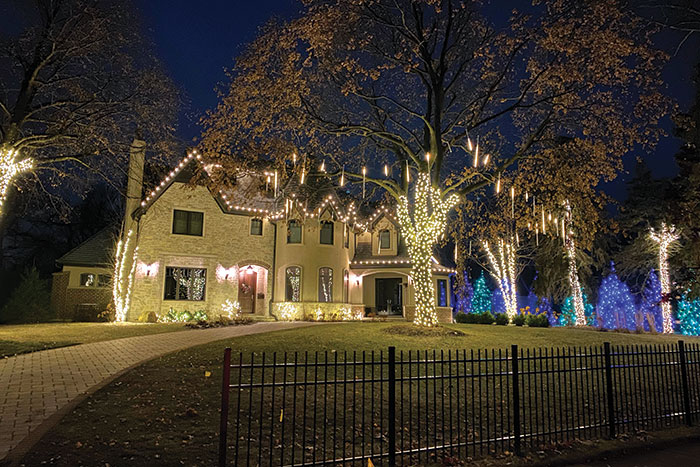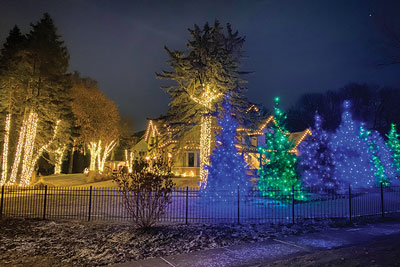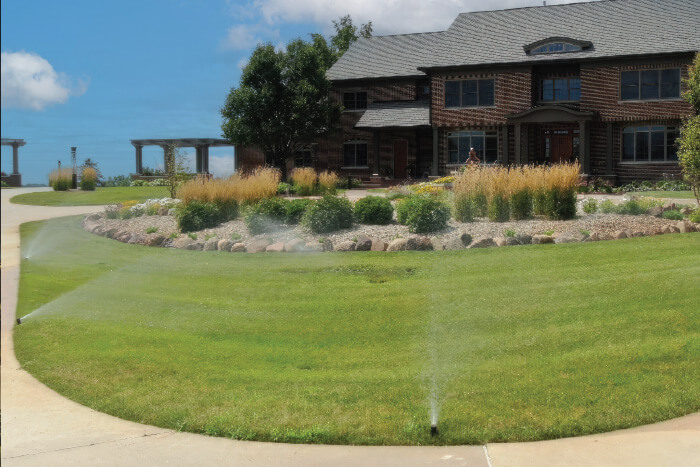Homeowners and commercial property managers who want festive holiday lighting without a Clark Griswold “Christmas Vacation” result know the value of hiring expert designers and installers. In the Chicagoland area of Illinois, Gary Fouts, owner of Principle Lighting Inc., has carved out a niche installing holiday lighting, landscape and architectural lighting, and providing event decorating services.
Holiday lighting has been an integral part of Fouts’ business model since 1991. Many of the company’s clients are repeat customers on both the residential and commercial sides.
Good communication and transparent conversations about customer expectations and deliverable services have supported Fouts’ efforts to develop a sustainable business.
When one of Principle Lighting’s longtime customers moved into a new home across town, there was no question whether the property owners would call for an appointment for holiday lighting. Positioned on a corner lot, the 12,700-square-foot home and surrounding yard offered ample opportunity for lighting multiple trees, shrubs and features without looking cramped.
The project used nearly 14,000 lights, a combination of C9, C7, mini-lights and tube lights. They lit the roofline, 10 evergreen trees and several shrubs. Rob Dupre, account manager, estimates it took a team of four crew members to install the job in about 40 hours.
“It was a good number of lights for a residential property,” Dupre says.
Given that the company had served the clients for more than 10 years, they knew the couple well and had established solid lines of communication before discussing the new project. But Dupre remembers being surprised by the couple’s color requests, a combination of purple, green and blue.
“I remember thinking ‘How are we going to incorporate all of that color?’ The wife likes white and husband likes color,” he says. “I said OK, that’s what we’ll get you. I was very pleasantly surprised how good all those colors looked, and it looked really good with the white.”
Getting started
Based in New Lenox, Illinois, Principle Lighting is Gary Fouts’ second career. His first was as a math and science teacher. Looking for a way to support his family so that his wife could stay home and he wouldn’t need to pick up a second job, Fouts launched his full-service landscape company. What started as one man with a lawn mower, quickly grew into a multi-franchise corporation with 8-10 employees devoted to installing lighting in October and then increasing the crew to 12-15 during the Christmas season. He credits communication and relationships as the keys to his success.
With this holiday lighting job, Fouts and Dupre knew the customers and their design preferences. Despite the familiarity, they didn’t skip an in-person visit. Dupre estimates spending an hour walking the property with the homeowners explaining options on color and areas to be lit.
 “At some appointments, clients only want roof lighting and a wreath, which is more straightforward to bid,” he says.
“At some appointments, clients only want roof lighting and a wreath, which is more straightforward to bid,” he says.
Dupre itemized the options on a tablet and reviewed four recommendations before leaving. The lot was an L-shape, so it wasn’t possible to do a digital rendering. The company has found only about 20% of their customers are interested in digital renderings.
“This was more involved, and I made several follow-up calls to get everything they wanted before the design was finished,” Dupre says.
Running electrical supply where it was needed was a significant challenge. The property only had power at the house, and many of the trees were quite a distance from the home. A circular driveway limited options for discreetly running extension cords.
“We ran some of the cords through the expansion joints so there was still a nice clean look,” Dupre says. “We also had to plan how to run the power so we didn’t overload the circuit.”
Since Principle Lighting regularly uses LED fixtures, load isn’t often an issue. But with the number of lights on this project they created zones powered by separate circuits to avoid tripping the ground fault interrupt breaker.
“Back in the incandescent world we wouldn’t have been able to do as much as we did on this property using LEDs,” Fouts says.
The accepted design proposal included tube lights hung from inside several trees. The tubular lights screw into a C9 cord. It was one of the first projects where Dupre used the lights, and he was interested to see the final effect. But within a few days of installation, a windstorm blew through, knocking the tube lights from the trees.
“I think they came unscrewed swinging in the wind because they are three to four feet long,” he says. “We had to go back and figure out how to prevent that from happening again.”
The drip lights are available in varying lengths and it was only the longer models, those 3-4 feet, that the wind bothered. Ultimately, Dupre wrapped each socket with electrical tape after screwing the bulbs in to keep the fixture in place. Because the lights are hung 15-20 feet up in the tree, the electrical tape wasn’t visible. The fix worked for the remainder of the season.
“I hadn’t used these lights a whole lot.
We mostly used them on interior jobs. My thought was since the tubes were screwed into the cord, they would be fine. But all the movement loosened them,” Dupre says. “The drip tubes are really cool now that we know what we need to do. We’ll use them more often.”
Safety first
The home’s roofline included unique features spread across multiple heights and levels. Multiple peaks, dormers and turrets offered ample opportunity for creative lighting. The varying levels meant finding ways to splice light strands together to avoid lights randomly dangling in dead space between a roofline change.
“The crispness of how we hang lights on rooflines distinguishes our jobs from others,” Dupre says. “We make sure the power cords are held into place with roof clips and the extension cords are disguised for that finished look.”
Attention to detail includes safety. Figuring out how to safely position workers on the roof and have access to all the areas to be lit takes the right tools. In addition to having the appropriate ladders, they provide employees with traction devices that strap-on their boots. Called Cougar Paws, the footwear accessories are like a pillow to protect the roof and add traction, Fouts explains.
“The first thing we tell our guys is if you’re not comfortable with the height or the roof to let us know,” Fouts says. “We’re not going to risk someone’s life on a peak, and I will communicate that with the customer.”
With a tricky, multi-roof like the one on this property, Fouts tries to convince customers to allow installation as early as late September on commercial properties and October for residential projects. Winter weather synonymous with the Midwest makes roofs slippery. Even a thin layer of frost that melts midmorning can create dangerous situations.
Although the lights aren’t turned on that early, Fouts sees an opportunity to install when weather isn’t as challenging. Now that the color of some lights can be changed from a smartphone app, he’s hoping he can convince customers to start jobs early. They could choose a Halloween theme that can be easily transformed into Christmas with the click of a button.
“We may try to push the envelope and encourage customers to consider the possibilities for Halloween lighting,” he says.
Traditional, modern, retro and festive holiday lighting options ensure that every customer can have the look that fits their home and tastes.
“We don’t do loops where the lights are just circled around the trees,” he says. “Our guys work the lights in and out of the tree. The goal is so that you can’t follow the strand of lights when you look at the tree.”
On this particular project, the crew surprised Dupre with the final results on the evergreen trees. The lights followed the trunk up 30-40 feet. Even Dupre was shocked by the height of the lights. The workers continued winding lights up the trunk, climbing higher into each tree until the full amount of lights budgeted for the tree was used.
“When I was driving to the house, I couldn’t believe how far away I could see those trees. They really did an amazing job,” Dupre says.
A successful job like this one starts with the personal touch. The clients have opted to use the same design for their holiday lights this fall.
A few newly added shrubs and new plantings may increase the lights slightly and the color may change, but how the property features are decorated will remain the same.
“We try to be upfront and set the expectation level to make sure that we are on the same page with what they are getting and how it will be done,” Fouts says. “If there’s something I don’t think is safe or financially makes sense, I’ll explain why.”





